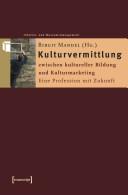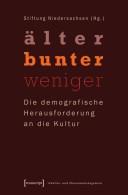| Listing 1 - 10 of 234 | << page >> |
Sort by
|

ISBN: 3839401747 3899421744 Year: 2015 Publisher: Bielefeld transcript Verlag
Abstract | Keywords | Export | Availability | Bookmark
 Loading...
Loading...Choose an application
- Reference Manager
- EndNote
- RefWorks (Direct export to RefWorks)
Ausstellungen kultur- und naturwissenschaftlicher Thematik gehören heute zu den wichtigsten Äußerungen kulturellen Lebens. Aber was geschieht eigentlich, wenn man ausstellt? Wie »wirklich« ist das Ausgestellte? Das Buch fasst Ausstellungen als »Wirklichkeitsspiele« auf, in denen die Bedeutung der Dinge nicht nur vermittelt, sondern auch neu ausgehandelt werden kann. Der von Alexander Klein gewählte Zugang legt die historischen Wurzeln des Ausstellens frei und untersucht sein spannungsreiches Verhältnis zum Sammeln. Dabei erweist sich, dass das Medium »wissenschaftliche Ausstellung« die Grenzen des konventionellen Museums sprengt. Ein bebilderter Teil mit einer kommentierten Auswahl von Exponaten rundet die Publikation ab.
Book

ISBN: 9080573515 Year: 2001 Publisher: Tilburg Stichting LCM
Abstract | Keywords | Export | Availability | Bookmark
 Loading...
Loading...Choose an application
- Reference Manager
- EndNote
- RefWorks (Direct export to RefWorks)
Museology --- Business management --- 037 --- museumwerking --- museum
Book
ISBN: 1474254969 1474254985 9781474254984 9781474254953 1474254950 9781474254977 1474254977 9781474254977 9781474254960 9781350040106 Year: 2017 Publisher: London Bloomsbury Academic, an imprint of Bloomsbury Publishing Plc
Abstract | Keywords | Export | Availability | Bookmark
 Loading...
Loading...Choose an application
- Reference Manager
- EndNote
- RefWorks (Direct export to RefWorks)
Small museums. --- Museums --- Museology --- museums [institutions]
Book
ISBN: 3839451914 Year: 2020 Publisher: Bielefeld transcript Verlag
Abstract | Keywords | Export | Availability | Bookmark
 Loading...
Loading...Choose an application
- Reference Manager
- EndNote
- RefWorks (Direct export to RefWorks)
In remote areas of Europe, local history museums struggle to connect with the rapidly changing and increasingly diverse communities around them. Insa Müller asks how these museums can recast themselves to strengthen the links to their communities. Combining theoretical deliberations, empirical investigations of the case of two Norwegian islands and a museum experiment, she offers starting points for rethinking the local history museum, while at the same time providing suggestions for locally adapted museum practice.
Heritage Studies; Local History; Museum; Museology; Community Museology; Memory Culture; Globalization; Museum Education; Cultural History --- Community Museology. --- Cultural History. --- Globalization. --- Local History. --- Memory Culture. --- Museology. --- Museum Education. --- Museum.
Book
ISBN: 2895442533 1435625439 9781435625433 9782895442530 Year: 2001 Publisher: [Sainte-Foy, Québec] Éditions Multimondes
Abstract | Keywords | Export | Availability | Bookmark
 Loading...
Loading...Choose an application
- Reference Manager
- EndNote
- RefWorks (Direct export to RefWorks)
Museum techniques --- Museology --- Museums --- Study and teaching. --- Technique --- Applied museology --- Museography --- Museum practices --- Museum studies
Book
ISBN: 1442276770 9781442276772 9781941963036 194196303X Year: 2015 Publisher: Washington, D.C. The AAM Press
Abstract | Keywords | Export | Availability | Bookmark
 Loading...
Loading...Choose an application
- Reference Manager
- EndNote
- RefWorks (Direct export to RefWorks)
In Cities, Museums and Soft Power, museum planners Gail Lord and Ngaire Blankenberg demonstrate how museums and cities are using their soft power to address some of the most important issues of our time. Soft power is the exercise of influence through attraction, persuasion, and agenda setting rather than military or economic coercion.
Museums --- City and town life. --- Social aspects. --- Economic aspects. --- Museology --- museology --- community development --- cities --- museums [institutions]

ISBN: 3839402255 3899422252 9783839402252 Year: 2015 Publisher: Bielefeld transcript Verlag
Abstract | Keywords | Export | Availability | Bookmark
 Loading...
Loading...Choose an application
- Reference Manager
- EndNote
- RefWorks (Direct export to RefWorks)
Ohne Frage hat Religion Konjunktur. Einerseits gilt Religion als Ressource von Sinn und spiritueller Erfahrung, andererseits ist sie Konfliktpotential. Zunehmend wird Religion auch zum Gegenstand von visuellen und textlichen Repräsentationen in Museen und Ausstellungen. Solche musealen Inszenierungen von Religion/en transportieren jedoch immer ein spezifisches Religionskonzept und beziehen, meist unausgesprochen, Stellung in aktuellen gesellschaftlichen Wertedebatten. Eine religionswissenschaftliche und museologische Reflexion dieses Zusammenhanges ist daher geboten und wird mit dieser Aufsatzsammlung erstmals in systematischer und praxisorientierter Form geleistet. Hierbei werden religionshistorische und sammlungsgeschichtliche Aspekte ebenso berücksichtigt wie aktuelle Ausstellungs- und Museumskonzepte. Für alle, die sich mit Religion und deren Repräsentation im Rahmen von Ausstellungen beschäftigen, bietet der Band damit wichtige Hilfestellungen. »Der vorliegende Band ist ein material- und konzeptreicher Beitrag zur Religionsästhetik, die sich in der Religionswissenschaft als Subdisziplin zu formieren beginnt. Seine Einleitung in den Band gibt einen bislang einzigartigen Überblick zur Wahrnehmungsgeschichte des religiösen Objektes von seiner Verkennung, Abwertung und Konstruktion als Fremdes bis endlich zu seiner Aufnahme in den religionswissenschaftlichen Fragenkanon.« Vera Ziegeldorf, H-Soz-u-Kult, 1 (2005)
Book
ISBN: 3839403146 3899423143 Year: 2015 Publisher: Bielefeld transcript Verlag
Abstract | Keywords | Export | Availability | Bookmark
 Loading...
Loading...Choose an application
- Reference Manager
- EndNote
- RefWorks (Direct export to RefWorks)
Im Zuge des historischen und medialen Umbruchs am Ende des 20. Jahrhunderts haben sich Ort, Raum und Architektur der Ausstellung und damit verbunden der Prozess des Ausstellens radikal verändert. Der umfangreiche, bebilderte Band gibt Einblick in aktuelle Ausstellungsästhetiken von Künstler- und Literaturhäusern. Beiträge aus Theorie und Praxis reflektieren facettenreich die neuen Formen und Möglichkeiten der Inszenierung und Ausstellbarkeit von Kunst und Literatur, von Bild und Text sowie von künstlerischen Biografien und Lebensformen im medialen Zeitalter. Besprochen in: www. ebensolch.at, 21 (2006), Ch. Ranseder
Book
ISBN: 9789462702332 9789461663320 9461663323 9462702330 Year: 2020 Publisher: Leuven Leuven University Press
Abstract | Keywords | Export | Availability | Bookmark
 Loading...
Loading...Choose an application
- Reference Manager
- EndNote
- RefWorks (Direct export to RefWorks)
Held on the occasion of Louvre Abu Dhabi?s first anniversary, the symposium 'Worlds in a Museum' addressed the topic of museums in the era of globalisation, exploring contemporary museology and the preservation and presentation of culture within the context of changing societies. Departing from the historical museum structure inherited from the Enlightenment, leading experts from art, cultural, and academic institutions explore present-day achievements and challenges in the study, display and interpretation of art, history, and artefacts. How are ?global? and ?local? objects and narratives balanced - particularly in consideration of diverse audiences? How do we foster perspective and multiculturalism while addressing politicised notions of centre and periphery? As they abandon classical canons and categories, how are museums and cultural entities redefining themselves beyond predefined concepts of geography and history?0This collection of essays arises from the symposium 'Worlds in a Museum' organised by Louvre Abu Dhabi and École du Louvre.
Museology --- museology --- Museum techniques --- Culture and globalization --- Globalization and culture --- Globalization --- Museums --- Technique --- Applied museology --- Museography --- Museum practices --- Museum studies --- Culture and globalization. --- Museum techniques.
Book
ISBN: 2912025370 2810709963 9782810709960 Year: 2008 Publisher: Toulouse CNRS
Abstract | Keywords | Export | Availability | Bookmark
 Loading...
Loading...Choose an application
- Reference Manager
- EndNote
- RefWorks (Direct export to RefWorks)
Otto Wilhelm Kuusinen est surtout connu pour avoir été pendant quinze ans l’un des secrétaires du Komintern, puis plus tard l’un des conseillers de Nikita Krouchtchev. En Finlande même, il incarne pour beaucoup la figure par excellence d’un communisme apatride, lié à « l’ennemi héréditaire ». Il fut pourtant de 1905 à 1918 un dirigeant social démocrate finlandais de premier plan, qui plus est patriote ardent et rédacteur de maints textes réclamant ou préparant l’indépendance du pays en 1917. Le présent ouvrage s’intéresse spécifiquement à cette partie-là de la vie de Kuusinen, non seulement parce qu’elle est souvent occultée, voire négligée par les historiens, mais aussi parce qu’elle pose le problème des continuités et des ruptures dans la vie d’un dirigeant du mouvement ouvrier dont la carrière a embrassé plusieurs époques distinctes. Le but de ce livre n’est toutefois pas d’être simplement une biographie, au sens classique du terme. Il s’agit aussi dans ces pages de comprendre pourquoi un jeune homme, que rien ne prédisposait a priori à devenir un révolutionnaire, s’est découvert et forgé une âme de socialiste, pourquoi il a en outre abandonné ses rêves d’ascension sociale pour embrasser une carrière aléatoire au sein d’un mouvement ouvrier qui lui était à l’origine étranger. Les raisons en fait apparaissent complexes, mêlant des facteurs structurels et conjoncturels, familiaux et sociétaux, individuels et organisationnels. Au total, il apparaît que l’engagement politique, au sens que lui a donné le xxe siècle, ne peut se réduire aux choix d’une personne ; il a également une dimension collective qui l’enracine profondément dans la société qu’il prétend transformer. C’est pourquoi le lecteur pourra découvrir, tout autant que l’individu Kuusinen, la Finlande des années 1881-1918, les mutations socio-économiques qui l’affectent, les débats intellectuels et politiques qui s’y déploient, les espérances et les colères qui animent les contemporains, la dureté enfin…
Migration. Refugees --- Museology --- History --- révolution --- engagement politique --- mouvement ouvrier --- socialisme
| Listing 1 - 10 of 234 | << page >> |
Sort by
|

 Search
Search Feedback
Feedback About UniCat
About UniCat  Help
Help News
News